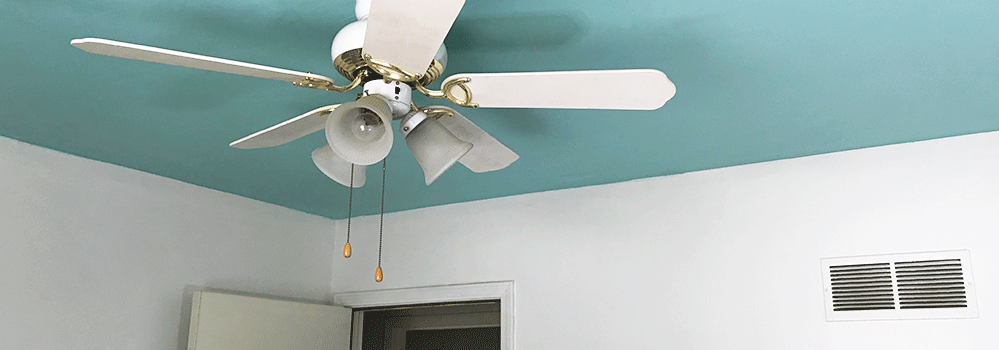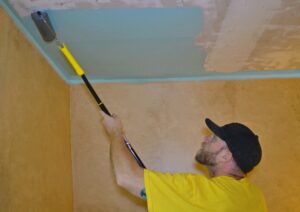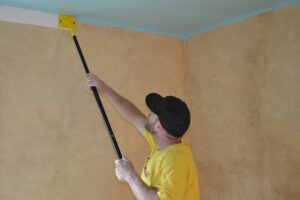In part one we went over the materials needed, prep work and how to wet down and remove popcorn ceiling and sanding. This second and final chapter in our ceiling painting saga we’ll discuss color/paint choices, the process of how to paint and a very specific product Mr. LongArm created just for this type of application.
What to Consider When Choosing a Color
Generally speaking paint choice comes down to only a few options. A ceiling that is painted lighter than the rooms walls will appear higher, which is great for smaller rooms. A dark color will make the ceiling feel lower (but think intimate or cozy not necessarily “the walls are closing in!”). And ceiling paint is usually flat, but sometimes, especially with a darker ceiling, eggshell or satin finish can add texture to the room. Do be aware that a higher sheen paint will reveal imperfections in the ceiling which may have resulted from scraping if you previously had a popcorn ceiling.
Cutting in the Joints Between the Wall and Ceiling.
Now it’s time to get to the good part. Lay down clean dust-free drop cloths. We recommend starting with the ceiling. Using your favorite paint brush, by hand or with our Brush & Tool Holder, begin to cut in at the joint of the walls and ceiling. Paint far enough from the wall so that you can safely use a paint roller in the next step and not run the risk of bumping into the walls. If you are planning on painting the walls as well as the ceiling, it’s perfectly fine to overlap some of the ceiling paint onto the walls. If you aren’t painting your walls, run painter’s tape to keep paint where it belongs, but make sure to take your time so that the seam of the drywall is covered with the ceiling paint. This step is very important because the eye will notice any gaps in color.
Rolling the Ceiling
With the cut in finished you can turn your attention to rolling. Not to toot our own horn too much, but Mr. LongArm has designed a product specifically for the purpose of keeping paint splattering to an absolute minimum. We highly recommend our Smart Painter II to handle this portion of your project (as well as the walls if you are moving on past the scope of this guide). The most unique feature of the Smart Painter II is our Splatter Guard that covers the roller. The guard keeps the paint on the ceiling and not on you. Roll out the ceiling as you would a wall. Make sure to keep the roller loaded, but not enough that the paint drips down after you’re finished with a spot.
Painting the Walls
Once finished with the ceiling you can move on to the walls. We used the Mr. LongArm Trim Smart Paint Edger it makes a crisp clear paint line along the newly painted ceiling. It’s safer than using a ladder, and if you keep a smooth steady motion it’s much faster than a brush.
And there you have it! A step by step guide that will bring a major facelift to just about any room in the house with a little bit of a work and a few specialized tools. If this guide helps give you the motivation or the know-how to change up the ceilings in your home we’d love to see the results! Feel free to contact us and send us pictures of your beautiful newly painted ceilings!
Related Articles: How-to Guide: Painting a Ceiling – Part One






3 thoughts on “How-to Guide: Painting a Ceiling – Part Two”
I’m so glad you shared this How-to Guide: Painting a Ceiling with me! As someone who has just moved into a new house, I’ve been looking for ways to spruce up the place, and this guide looks like it will be really helpful. After reading through it, I’ve learned that it’s important to pick the right paint and primer, prepare the surface properly, and use the right tools in order to ensure a successful paint job. It also looks like I’ll need to take steps to protect my furniture and floors, as well as myself, from any paint splatters. I’m looking forward to getting started on my ceiling painting project, and I’m confident I’ll be successful with the help of this post.
Thank you for your comment and best of luck with your project!